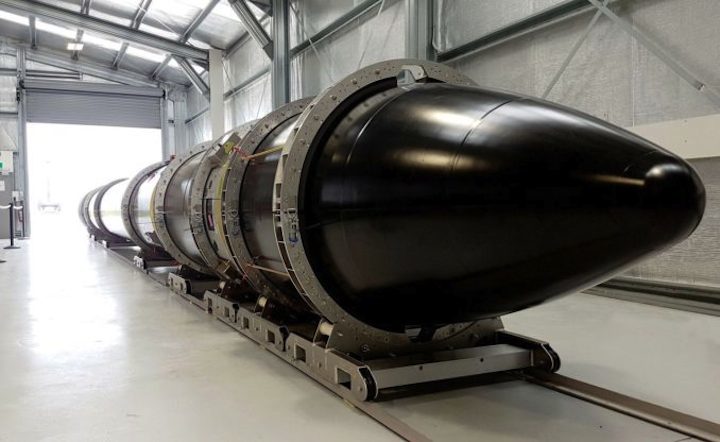19.01.2018 / 19.00 MEZ
Second Electron rocket shipped to New Zealand launch site

Roll-out preparations are well underway today at Launch Complex-1. Tomorrow's four hour launch window opens at 14:30 NZDT (17:30 PT/ 20:30 ET / 1:30 UTC). Once again, we'll be waiting for ideal launch conditions. More updates to follow!
+++
Rocket Lab to open ‘Still Testing’ launch window on January 20

Thursday January 11, 2018: Rocket Lab, a US aerospace company with operations in New Zealand, will open a nine-day launch window from Saturday January 20, 2018 (NZDT) to carry out the company’s second test launch of the Electron rocket. During this time a four-hour launch window will open daily from 2:30 p.m. NZDT.
The test launch, titled ‘Still Testing’, will take place from Rocket Lab’s Launch Complex 1 on the Māhia Peninsula, New Zealand. It follows on from the successful inaugural Electron test carried out on May 25, 2017.
Still Testing will carry an Earth-imaging Dove satellite for Planet and two Lemur-2 satellites for Spire for weather and ship tracking, enabling Rocket Lab to gather crucial data and test systems for the deployment stage of a mission.
Peter Beck, Founder and CEO of Rocket Lab, says the test is an important next step in democratizing access to space to empower humanity.
“Increased access to space will vastly improve humanity’s ability to build out orbital infrastructure, such as constellations of weather and Earth-imaging satellites. These will provide better data about our planet and enable us as a species to make informed decisions about how we better manage our impact. This test launch is a crucial next step in gathering more data about the Electron launch vehicle so we can deliver on this future,” he says.
“Once again, we’re expecting to scrub multiple times as we wait for perfect conditions and make sure everything on the vehicle is performing as it should.”
The test launch attempt will only proceed if conditions are ideal for launch. Due to the nature of launching rockets, planned lift-offs are often subject to multiple and subsequent postponements, or scrubs, to allow for small, technical modifications and to wait for ideal weather conditions.
The Still Testing launch attempt will be live streamed to the public. A live video stream will be available approximately 15 minutes prior to a launch attempt and will be viewable on YouTube and at www.rocketlabusa.com
Quelle: RocketLab
+++
Update: 22.20 MEZ
Electron is vertical on the pad at Launch Complex-1

Quelle: RocketLab
+++
Update: 20.01.2018

Quelle: RocketLab
+++
Rocket Lab forced to abort launch again
New Zealand-based space company Rocket Lab has failed to launch a test rocket from Mahia Peninsula due to two rogue vessels and weather.
Rocket Lab's latest test launch hasn't quite gone to plan after two rogue vessels were spotted in the vicinity.
The Electron rocket failed to make it into the skies on Saturday with the launch put on hold in the final moments, due to the vessels.
A second attempt later in the day didn't come to fruition either due to weather implications.
This was Rocket Lab's second attempt to complete the test launch - in December it came within two seconds of lift-off before the countdown was aborted because of "rising liquid oxygen temperatures" not compatible with the afternoon's warm conditions.
Shortly after, it suspended launch attempts until early 2018.
The flight will be the second for Rocket Lab and will carry small Earth-imaging satellites for US companies Planet Labs and Spire Global.
The company's inaugural test last May reached space but didn't make it into orbit after a communication fault forced the flight to be aborted early.
Rocket Lab will make another attempt to launch on Sunday afternoon.
Quelle: NZCity
---
Update: 21.01.2018
.
Rocket Lab successfully reaches orbit and deploys payloads

Huntington Beach, California and Auckland, New Zealand January 21 2018:
Rocket Lab has successfully reached orbit with the test flight of its second Electron orbital launch vehicle, Still Testing. Electron lifted-off at 14:43 NZDT from Rocket Lab Launch Complex 1 on the Māhia Peninsula in New Zealand.
Following successful first and second stage burns, Electron reached orbit and deployed customer payloads at 8 minutes and 31 seconds after lift-off.
“Today marks the beginning of a new era in commercial access to space. We’re thrilled to reach this milestone so quickly after our first test launch,” says Rocket Lab CEO and founder Peter Beck. “Our incredibly dedicated and talented team have worked tirelessly to develop, build and launch Electron. I’m immensely proud of what they have achieved today.”
“Reaching orbit on a second test flight is significant on its own, but successfully deploying customer payloads so early in a new rocket program is almost unprecedented. Rocket Lab was founded on the principal of opening access to space to better understand our planet and improve life on it. Today we took a significant step towards that,” he says.
In the coming weeks Rocket Lab engineers will analyse the data from today’s launch to inform future launches. Rocket Lab currently has five Electron vehicles in production, with the next launch expected to take place in early 2018. At full production, Rocket Lab expects to launch more than 50 times a year, and is regulated to launch up to 120 times a year, more than any other commercial or government launch provider in history.
Still Testing was carrying a Dove Pioneer Earth-imaging satellite for launch customer Planet, as well as two Lemur-2 satellites for weather and ship tracking company Spire.
Rocket Lab’s commercial phase will see Electron fly already-signed customers including NASA, Spire, Planet, Moon Express and Spaceflight.













































